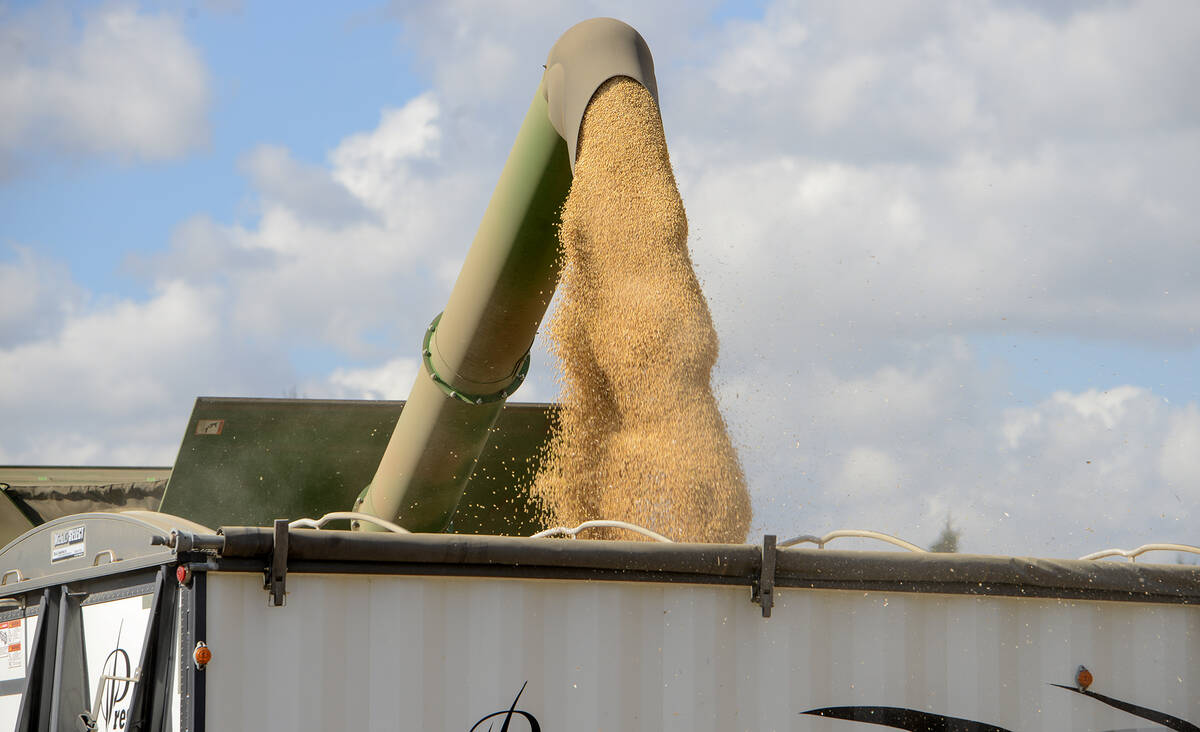Future Canadian farmers will be able to expect both better yield and more stress tolerance out of their canola crop, if researchers at the University of Guelph have anything to say about it, and they’ll have gene editing techniques to thank.
The Guelph team is well into the process of developing a more robust, transgenic canola plant that produces bigger stems and increased biomass without impacting oilseed quality.
“(We have) increased numbers of stems up to 60 per cent, increased numbers of siliques (seed pods) up to 40 per cent and a total seed yield per plant increase of 35 per cent,” said Ian Tetlow, a professor with U of G’s department of molecular and cellular biology.
Read Also

Grain markets hungry for U.S. data
The U.S. government shutdown meant that futures markets were left without robust grain supply information
“We’re using gene editing to improve canola yield, but as a result of some of the work we’ve done, it’s also enabled us to protect that yield and increase stress tolerance in the plants that we’ve produced.”
WHY IT MATTERS: Conventional crop sectors have hailed gene editing for its potential to speed up variety development compared to older gene modification technology.
The high-biomass canola may be less prone to lodging, although the researchers have not yet been able to test that theory in the field.
It does, however, appear to perform well under drought and heat, said Tetlow, speaking at the Canola AgriScience Cluster Research Roundup webinar June 26.
“When these plants are droughted, you can see there’s an increase over the wild type (canola) in seed, seed weight, seed yield per plant, and this is extended further under heat treatment.”
It may also come with increased resilience against heavy-hitting canola diseases like sclerotinia and clubroot, he added.
Maize enzymes fuel growth
The team — comprised of Tetlow, Liping Wang and Michael Emes — used CRISPR-Cas9 gene editing technology to “knock out” some canola genes and stitch in replacement genetic information from maize.
CRISPR acts as a proverbial set of gene-editing scissors, allowing scientists to more precisely single out, “snip,” and modify DNA sequences.

The project built on previous studies experimenting with thale cress, another brassica plant that shares genetic similarities with canola. In that study, scientists targeted endogenous starch branching enzymes (SBEs), enzymes key to the ability of a plant to produce its own starch and which help lay out that starch’s structure.
Without those enzymes, plants produced were small and unable to produce starch, but featured thickened stems. The project then added in genetic material associated with SBE expression in maize. This restored starch production capability.
The result was more biomass, more branching, thicker stems and, potentially, better flow of carbon reserves around the plant.
The team mimicked those results in canola.
They don’t entirely understand why the change in both thale cress and canola had such huge benefits, Tetlow noted.
“When you think of improving yield on an oilseed crop, the logical thing perhaps to consider would be to manipulate the oil biosynthetic pathway,” he said.
“But that’s not what we’ve done. What we’ve done is improved the yield of this plant via an indirect mechanism, manipulating starch biosynthesis in the vegetative parts of the plant.”
Based on what they can see in the plants they’ve produced in controlled conditions, there is no impact to oilseed quality, Tetlow added.
Into the field
Of course, if the transgenic canola only works in controlled conditions rather than real-life production, it’s not much use to farmers.
The next step is bringing their genetic lines into the field to see how they fare.
Tetlow and his team are conducting field trials at two sites in Ontario. The plants are growing well, the researcher said. Past that, it’s too early to tell.
“The field trials are going to be important to hopefully demonstrate that we can maintain this increase in yield and biomass and also the protection from environmental stresses in the field,” he said.
“So that’s work ongoing. We’re in the process of conducting further heat tolerance and drought experiments and also looking at root growth and root architecture in these plants. So far, we’ve only looked at the aerial parts of the plant.”

He expects to report more fulsome results by next summer.
There are also other things the Guelph team would like to explore about the transgenic canola plants, such as investigating increased lignocellulose (a type of biomass) they’ve observed in the seed pods.
“There’s a whole suite of increased agronomic traits or improved performance traits associated with these plants that we’re in the process of examining and evaluating,” Tetlow said.
The Canola Council of Canada funded most of the gene-editing and transgenic work, said Tetlow. The Ontario Canola Growers Association is funding the Ontario field trials.
Gene editing and food security
Although developed through gene editing, the transgenic canola is likely classed under Canada’s more stringent regulatory pathway for genetically modified organisms (GMOs).
The federal government has loosened the leash on crops developed with gene editing in recent years, although those changes pertained to crops where gene editing was used to modify a plant’s existing genes. As of 2023, those crops have faced the same level of regulatory approval as those developed through conventional breeding.
Plants with foreign DNA added, however, are still considered to have novel plant traits, and must face Canada’s GMO hoops.
That decision was lauded by many conventional agriculture groups, although the organic sector continues to oppose the move, arguing that lack of traceability for gene edited crops and the risk of contamination are a threat to their industry.
Although controversial in some circles, gene editing isn’t going anywhere, said Stuart Smyth, a researcher at the University of Saskatchewan who has specialized in biotechnology regulation. In fact, he argued it may be a key to reducing world hunger.
“I think that in the next five to 10 years, we could make the most significant advancements to reducing global food insecurity by using this targeted knockout to get 10, 15, 20 per cent yield increases within a matter of a couple of years,” he said.
Such yield increases are already happening, he added, using the example of one Australian field trial for wheat two years ago.
“They knocked out one or two genes and they were getting an over 20 per cent yield increase. Now, in a field trial that’s going to be bumped up a little bit, but let’s say that correlates to 15 per cent. If you could commercialize that wheat in Africa, what a tremendous advantage.”
Canadian researchers, food companies and producers have been generally on board with genetic editing since the Health Canada and the Canadian Food Inspection Agency’s (CFIA) 2023 decision, he added.
“The only ones that are being really vocal are the same groups that have been opposing biotech in Canada for 25 plus years.”
There’s still work to do on the file, Smyth said.
Canada, for example, does not yet have a framework for the inevitable day someone wishes to conduct gene editing in livestock. That’s already on the table for our southern neighbour. Pigs gene edited to be resistant to porcine reproductive and respiratory syndrome are on track to being a commercial reality as soon as 2026 in the United States.
“We have no regulatory system for gene-edited livestock in Canada or even genetically modified livestock, so this sort of becomes our challenges,” says Smyth.
“And based on the changes that Health Canada (and) the CFIA have put in place, to me it looks like that’s intended for plants and maybe some food additives … gene-edited yeast or the bacteria for fermentation or something like that, but not necessarily pertaining to non-plant species.”
Farmer would ‘absolutely’ plant
Nicolea Dow runs a mixed farm with her father and brother east of Portage la Prairie, Man. She chairs the Manitoba Canola Growers research committee as well as the Western Canadian Canola and Canola/Rapeseed Recommending Committee.
These experiences have given her an appreciation for innovation, she said. So when asked if she would grow the University of Guelph line if it was made available today, her answer was a resounding “absolutely.”
“As a farmer, I’m very, very pro-innovation, particularly in canola. Anything that is going to give us a more robust plant is a win,” Dow said.

The researchers’ success makes her wonder if verticillium — another major canola disease, and one of increasing concern to Manitoba farmers — could be managed with more robust canola genetics.
“As a farmer, (when) I think of thicker stems, what does that give us for something for a disease like verticillium? What does a bigger, beefier plant do for some of these extreme weather conditions?” she said.
The gene editing involved does not bother Dow at all.
“I think Canada has obviously undergone some review in that regard in the last few years and I think, so far, the Canadian system has been really welcoming to innovation,” she said.
“I’ll just say genetic engineering … is a huge positive and I see it as likely the most important tool for a future for agriculture that’s going to give us sustainability, that’s going to give us growth and that’s going to let us combat challenges, whether it be climate challenges or disease or insects or any kind of pests.”
















